| The Moon - Details |
| HOME Best Lunar Planets Deepsky Misc Equipment Techniques Links |
| Whole Moons Details Miscellaneous Eclipse 2004 Eclipse 2007 |
| This page contains images of various Lunar details and features. Click the images to see full-sized ones. |
5 April 2006, Mare Serenetatis mosaic
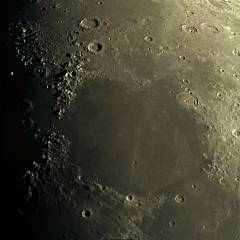
|
During the month of April I spent much of my time processing a mosaic of the Mare Serenitatis basin on the moon. This image was constructed from 13 separate pictures and shows the lava-filled "sea", the mountains separating the Serenitatis and Imbrium basins and the highlands and craters around the area.
|
| to top | home |
5 April 2006, Serenity-Tranquility lavas
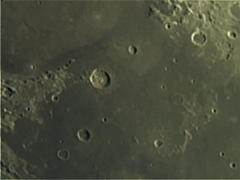
|
This image is an extract from the larger mosaic above. It shows the border between the Mare Serenitatis (Sea of Serenity) and Mare Tranquilitatis (the famous Sean of Tranquility). It clearly shows the areas of differeing lava and the border between the two Mare is remarkably well-defined.
Click the image for more details and a labelled map. |
| to top | home |
1 April 2006, Mare Crisium mosaic
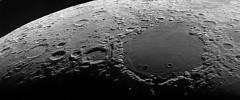
|
This is a mosaic showing the Sea of Crises, or Mare Crisium. The picture shows the multi-ringed basin structure quite clearly.
The mosaic was made of 6 overlapping sections, captured with TouCam plus IR blocking filter on my Europa 250 with 2x Barlow. I stacked between 600-1000 frames per section. Stacked in Registax, mosaic done in iMerge, post processing in PixInsight LE and The Gimp. |
| to top | home |
5 March 2006, Rabbi Levi Area
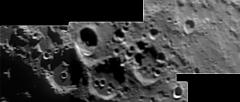
|
This is an area of the southern highlands, an area covered with craters of varying sizes. In this image some of the smalll shadow-filled craters have the appearance of animal pawprints! This image is a mosaic, created from four stacks of images captured on a night of below-average seeing.
Click the image for more details and a labelled map. |
| to top | home |
12 January 2006, Mare Frigoris and J Herschel in IR light
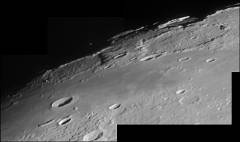
|
Here is my first picture of the new year, 2006: A mosaic showing the western area of Mare Frigoris in the North of the moon, and some of the large northern craters, particularly J Herschel and South.
This picture was captured using my IR-pass filter. This has helped show many details better than my usual visible-light images, which suffer more from poor atmospheric seeing. Click the picture for more details |
| to top | home |
12 January 2006, Aristarchus Plateau in IR light
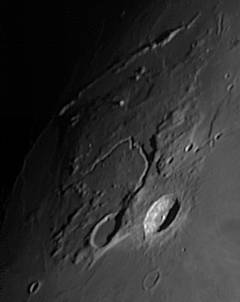
|
This picture is a mosaic that shows the Aristarchus plateau, a region of many interesting features including mountains, craters, and rilles.
This picture of the region was captured using my IR-pass filter. Compare with the image form 22 March 2005, which shows the same area in red light. Click the picture for more details |
| to top | home |
10 December 2005, South-West Mare Nubium mosaic
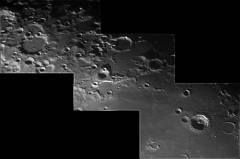
|
On 10 December I used my 2x Barlow lens on the Europa 250 to capture several AVIs of the South-western Mare Nubium region. I processed each image using Registax and Iris, then created a mosaic of the area. Click the image to see more detais.
|
| to top | home |
18 November 2005, Humboldt Crater in Infra-Red light
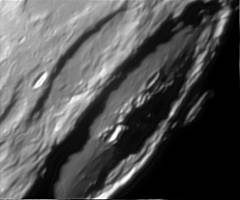
|
On 18 November I imaged the moon using my home-made IR-pass filter for the first time.
Humboldt is a spectacular crater but not often seen, because it lies in the zone of libration, which was favourable for Humboldt on this occasion, and furthermore is in the eastern edge, a side less frequently captured because you have to wait until after full moon. The large crater adjoining Humboldt immediately West is Phillips, whose walls are rather worn, showing the crater to be old.
This was the last crater I imaged during the evening but I was prompted to process it first by a mail in the Yahoo Lunar Observers group from Peter Grego, who drew it using his PDA. This image was captured with the Europa 250 f/4.8 scope with Televue 5x Powermate. Camera settings were: Exposure 1/33, gain 75%, B&W mode, gamma 0, fps: 10. |
I followed a novel (for me) processing technique:
| |
Hahn in Infra-Red light
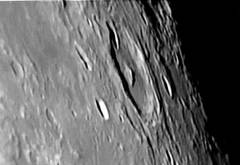
|
During the same session as the Humboldt image above, I captured an AVI of crater Hahn. The wall of the crater is overlapped by a smaller crater to the North, .nd the central mountain can be clearly seen in this image.
This image is a stack of 240 frames processed in Iris, again captured with 5x powermate on the Europa 250, using Toucam and home-made IR-pass filter. |
Gauss in Infra-Red light
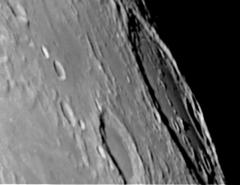
|
Another image from the same session on the night of 16-17 November 2005, this is crater Gauss. It is a large crater with many small craters on its floor as well as mountains.
This image is a stack of 300 frames, which I pre-processed using the Iris process described above, although the seeing was good in any case. There is some over-exposure on the left of the picture, as a result of the processing. Because of this the image could do with some reprocessing from the original data. |
| to top | home |
13 November 2005, Marius and Volcanic domes
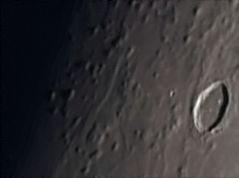
|
This image was captured in poor atmospheric seeing so isn't the best quality. it shows the crater "Marius" and some of the extensive area of domes, believed to be volcanic in origin, known as the Marius Hills.
This picture was captured with a Baader UV-IR blocking filter, with my ToUcam Pro and Televue 5x Powermate, on the Europa 250 Newtonian telescope. The best frames were stacked in K3CCDTools, then enhanced in PixInsight LE and The Gimp. |
| to top | home |
13 May 2005, Piccolomini and Rupes Altai
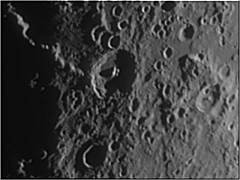
|
Rupes Altai is a ridge or cliff in the form of an arc concentric with Mare Nectaris. It appears to define part of the Nectaris Basin. Piccolomini is a crater to the south of Mare Nectaris and Rupes Altai can be seen here stretching from the crater off into the shadow of the terminator to the north-west.
Piccolomini itself is notable for its central mountain, whose four separate peaks and long shadow can be seen in this picture. The crater walls can be seen to be steep and terraced to some extent. To the east of Piccolomini, near the right-hand edge of this picture, and therefore under higher sun than that crater, is the crater Neander. It also has high terraced walls, and two smaller craterlets are visible on its floor, both close to a central mountain. |
|
North-west of Neander is a strange-looking feature that appears to be an almost triangular raised or ridged area, with at least one small crater embedded in it.This feature doesn't seem to have a name.
South of Piccolomini is a crater half its size, whose interior is completely shadowed in this picture. This is Stiborius, and it appears to be entirely within another larger crater, the left-hand portion (on this picture) of which is darkened by the shadow of Stiborius. The area to the right can be seen to contain rides and small craterlets. This picture was captured using a red filter, with my ToUcam Pro and a 2x Barlow lens, with an extension tube for higher magnification, on the Europa 250 newtonian. I captured 1000 frames and stacked the 300 best. Processing followed my usual pattern of Registax and The Gimp. | |
| to top | home |
13 May 2005, Janssen
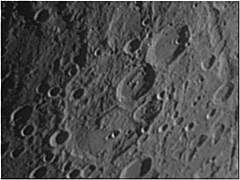
|
This picture of Janssen is under a much higher sun than my previous one, on 30 November 2004 (see below), and is worth comparing with last year's 25 April 2004 image, which was taken even later and with a higher sun still. Because of the solar angle, rather more detail is visible on this picture than the last year's one. Of interest are the two medium-sized circular craters Fabricus, which covers part of Janssen to the North East, and Metius, further North East.
Metius in particular is interesting because I don't have another picture showing its detail. The central mountain is small, and it has several craterlets around its floor and walls. The wall to the South West is wide and sloping, and adjoins Fabricus. |
| Fabricus itself has several mountains on its floor, arranged in a couple of short chains. To the west of Metius is a crater of around the same size, called Brenner. This crater is severely damaged and hardly recognisable as a crater, indicating its greater age than those around it.
On the floor of Janssen itself, the extensive rilles show up well here, as do the craterlets around its floor. Like Brenner, the damage and overlaid craters indicate that it is an older formation than some of its neighbours. To the east of Janssen and Metius is a wide valley apparently formed from a number of overlapping craters. This is Vallis Rheita, which starts from the crater Young and heads off to the North West. It was possibly formed by impacts from material ejected from Mare Nectaris, or as some think, the huge impact that created the Imbrium basin. | |
| to top | home |
13 May 2005, Mare Nectaris
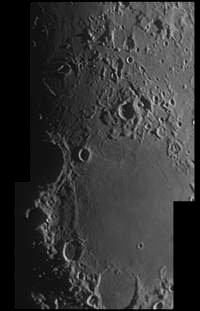
|
The Sea of Nectar, or Mare Nectaris, is shown here in another red-light image. This is a lava-filled basin, whose outer walls are partly marked by Rupes Altai (see Piccolomini picture above). Overlapping the Mare to the south is a large crater called Fracastorius, which has been almost completely filled with Nectaris lava, to the extent that its Northern wall is no longer present. Still, the walls that remain are high and steep, and notably overlapped by a small crater known as Fracastorius D to the west, which is itself overlapped by yet another smaller crater.
To the North West of Fracastorius is a smaller crater Beaumont, which like Fracastorius, seems to have lost part of its wall to the Nectaris lavas. Immediately North of the Mare is a pair of small craters, Isidorus and Capella, which overlaps part of the Eastern wall of Isidorus. These make an interesting couple in a region much scarred presumably by debris from the creation of the Nectaris basin, and a linear scar known as Vallis Capella runs right across Capella. |
| South of Isidorus, in the upper part of the Mare, is an almost invisible crater, a "ghost" called Daguerre. It is completely submerged in the lava but most of the crater walls are clearly visible, and in the centre the remains of a central mountain marks the lava. To the crater's North West is another similar submerged crater. | |
| to top | home |
18 April 2005, many details
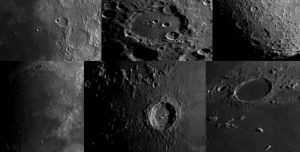
|
On 18 April 2005 the moon was at 9 days after new. I used the ToUCam with a 2x Barlow lens and captured a series of AVIs covering the whole moon. Click the picture to see some detailed images of features from this moon.
|
| to top | home |
25 March 2005, Mare Orientale region
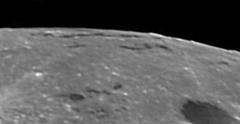
|
The Mare Orientale is a large circular basin just out of view of the normal earth-facing side of the moon. On occasions when the libration is favourable, the edge of the mare is just visible. Libration is when the moon tilts through different angles, allowing us to see more or less of different parts at different times.
On this occasion the mare was not quite visible, but various features can be identified on the photograph. Click the photo for a detailed annotated page. |
| to top | home |
22 March 2005, Sinus Iridum in Red Light
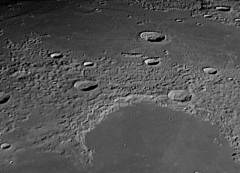
|
Following a tip from the QCUIAG Yahoo Group, I replaced the infra-red blocking filter on my ToUCam Pro with a simple red filter. This allows only the red and infra-red light, which is less susceptible to poor atmospheric seeing, through to the webcam's sensor.
I was very impressed with the results. This is an image of the Sinus Iridum, or the Bay of Rainbows, and an area of the Mare Frigoris to the north. This was imaged with the Europa 250 and a 2x Barlow lens. The camera settings were: 5 fps, Gamma 20, Saturation 0, shutter/gain auto (accidental but it worked!). 250 frames were stacked (out of 512 captured) in Registax 2, 2x resampled in stacking. The post-processing was sharpening, noise reduction, and brightness adjustment in The Gimp 2, and downsampled to 67%. |
| to top | home |
22 March 2005, Aristarchus Plateau in Red Light
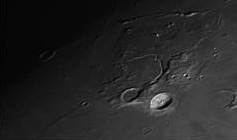
|
Another image in red light, like the one above, this is a detail of the Aristarchus Plateau, showing the crater Aristarchus with the pattern of light and dark on the inner crater wall clearly visible, and Herodotus with Schroter's Valley and other rilles around. Compare with the image from 25 October 2004 below.
This was imaged with the Europa 250 and a 2x Barlow lens. The camera settings were: 5 fps, Gamma 20, Saturation 0, shutter/gain auto (accidental but it worked!). 250 frames were stacked (out of 512 captured) in Registax 2, 2x resampled in stacking. The post-processing was sharpening, noise reduction, and brightness adjustment in The Gimp 2, and downsampled to 67%. |
| to top | home |
18 February 2005, Lunar Terminator Mosaic

|
This is a mosaic of the whole lunar terminator from Mare Frigoris in the North, through Mare Imbrium and smaller Mare Nubium below, and down to the Clavius region in the Southern Highlands. It was captured on the evening of 18 February, 2005. The mosaic is composed of 37 separate images, each a stack of between 150 and 180 frames, except a few that had less (I ran out of disk space capturing). It was captured with the ToUCam Pro with Baader UV-IR filter and Baader Contrast Booster, using a 2x Barlow on my 250mm f/4.8 newtonian.
The images were stacked in Registax 3, with 2x resampling, and merged in iMerge with resize to 67%. Then the larger image is half of that size.
There is a hole in the middle caused by a corrupt AVI so I filled it with grey! Click the picture for a normal image, or HERE for a very large one. The bigger image is ideal for viewing with the "Scroll" utility on Jan Timmermans site, and available at http://www.madpc.net/~firmament/astro/scroll.zip |
| to top | home |
18 February 2005, Enhanced Colour
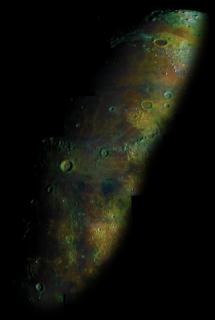
|
This very strange-looking picture of the Mare Imbrium region, has had the colour saturation enhanced using the technique described by Filipe Alves in his web page. The result shows the different soil compositions and the geologial makeup of this area of the moon.
This is a mosaic of 17 pieces using the ToUCam Pro and the 250mm f/4.8 Newtonian. Each piece was comprised of around 175 frames stacked in Registax 3. The mosaic was created using iMerge, and colour processing done in The Gimp 2. I've reduced its size considerably for this image because the full mosaic is very large. |
| to top | home |
20 December 2004, Montes Caucasus and Cassini

|
This picture shows the Caucasus mountains, which form the eastern boundary of the Mare Imbrium. The crater towards the top-left of the picture, contatining two smaller craters,
is Cassini.
This picture was created from the best 500 frames of 1385 captured via 2x Barlow with the Toucam pro on the Europa 250, then stacked in Registax. A Baader UV-IR blocker filter was used. After stacking and applying wavelets in Registax, slight post processing was performed in the Gimp. |
| to top | home |
30 November 2004, Janssen
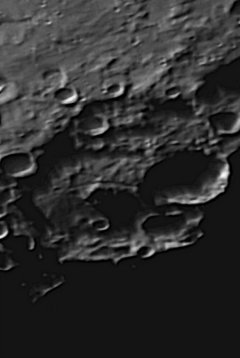
|
Here is another picture of Janssen (compare 25 April 2004). In this picture the sun is very low and the shadows are consequently long, showing the surface features very well. Janssen is a more-or-less hexagonal crater, containing many interesting objects, such as the crater Fabricus, which crushes the wall of Janssen, and the promenant Rille network (Rimae Janssen).
This picture is a stack of 966 frames taken from around 1300 captured with the ToUCam pro and 2x Barlow lens, plus an extension tube made from an old Barlow with the lens removed. The extension increases the magnification obtained from the Barlow lens. The frames were stacked in Registax and post-processed using The Gimp. |
| to top | home |
30 November 2004, Posidonius and Rima G. Bond
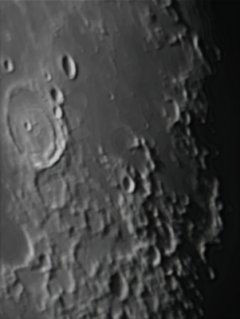
|
Posidonius is an interesting crater on the edge of Mare Serenitatis. Of interest also is the damaged crater Chacornac to the South East. To the North and East of Posidonius is a flat area called Lacus Somniurum. On the East of Posidonius and Chacornac and running from Lacus Somniurum in the North to the mountains in the South, is a large Rille called Rima G. Bond. It is just visible in this picture, although it helps to know where it is!
This picture is a stack of 1000 frames taken with the ToUCam pro and 2x Barlow lens with a new telescope, a 250mm f/4.8 Newtonian. The frames were stacked in Registax and post-processed using The Gimp, as always. |
| to top | home |
4 November 2004, Rupes Recta
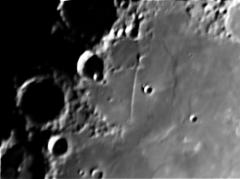
|
Rupes Recta is a linear fault scarp in the Mare Nubium to the South West of the three-crater sequence of Ptolemarus, Alphonsus, and Arzachel, and is sometimes known as the "Straight Wall". However it has now been established that it is not a wall-like feature at all, but rather a gentle slope. However the old name has stuck.
On this picture, comprised of a stack of 599 frames taken with the ToUCam pro and 2x Barlow lens, you can see the "wall" itself forming a distinctive sword shape (with the handle uppermost, this is known as Huygens' Sword, named after the well-known astronomer who discovered the feature. To the left (the East in this South-upwards picture) is the set of overlapping craters Thebit, Thebit A, and Thebit L. To the West is a small crater, and running North from that crater and parallel with Rupes Recta is a smaller rille that was discovered by Schroeter, although it is practically invisible in this picture. |
| to top | home |
4 November 2004, Plato and Montes Teneriffe

|
Near the crater Plato on the Northern side of the Mare Imbrium, is a small group of mountains known as Montes Teneriffe (they are on the left of the crater in this picture). Close by (the bright object below the crater) is another mountain called Mons Pico. ALl these mountains are approximately 2400m high. Mons Pico is near the Southernmost edge of a "ghost crater", whose northern edge touches the edge of Plato, and whose outline can be seen as ridges in the mare lava. |
| to top | home |
26 October 2004: Schickard
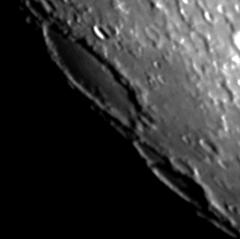
|
The picture here shows craters Schickard and Phocylides right on the edge of the shadow terminator. Schickard is a huge lava-filled crater with a flat floor although, as would be expected, it does contain some smaller craters. The bottom also contains some black and white markings although neither these nor the smaller craters are particularly noticable in this image because of the angle at which the crater is seen.
This picture was captured with the ToUcam pro and 2x Barlow lens on my 200mm f/5 reflector. I stacked 200 frames to create this image. |
| to top | home |
26 October 2004: Mare Frigoris
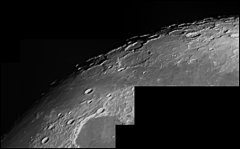
|
North of the Imbrium basin lies the Mare Frigoris. This picture, taken when the moon was 12 days and 16 hours after new, shows many features of the area. Click the picture to see the details.N |
| to top | home |
25 October 2004: Aristarchus and Herodotus area
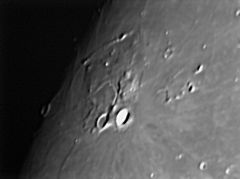
|
Just before the moon is full, when the moon is 14 days old, this interesting region of the moon comes into view. The craters Aristarchus and Herodotus have various rilles, valleys, and mountains associated with them. Click the picture to see the details. |
| to top | home |
24 October 2004: Mare Imbrium
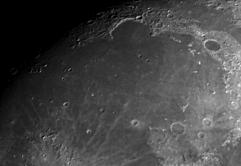
|
The 10-day moon shows the Mare Imbrium, the largest impact basin on the moon, well. This picture shows the whole fascinating "sea", including the Bay of Rainbows (or Sinus Iridum) bounded by the Montes Jura mountains, the crater Plato on the North Eastern shore with the Montes Alpes. Gassendi sneaks in on the right of this picture, a little indistinct due to the angle of the sun, as too is Archimedes and its associated mountains to the South.
The whole Mare is dotted with craters and traversed by lava snakes, but most promenant are the vast bright rays that shoot across from craters Copernicus, off the picture to the south (although the mountains around it, Montes Carpatus, are clear), and Aristillus, to the Northeast of Archimedes on the lower right of the picture. |
| to top | home |
24 October 2004: Gassendi
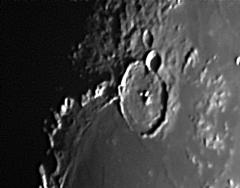
|
Spanning the northern edge of the Mare Humorum is a large crater called Gassendi, the interior of which has many details - several Rilles, double or triple central mountains, and many rocky and hilly regions. The southernmost part of the crater wall has been submerged into the lava of the Mare, and although most of Gassendi's crater floor is lighter than Mare Humorum, the part adjacent to this break in the wall is the same colour, apparently formed of lava spilling in from the south. The border between this lava area and the rest of the crater is marked by a partial ring-like formation of hills, lower than the central mountains, but distinctive.
The smaller crater adjoining Gassendi to the North is known as Gassendi A, with B to the Northwest of A. |
| to top | home |
04 September 2004: Clavius

|
Here is another view of Clavius (contrast with the one from 30 March, shown below). This one shows the sunlit limb of the moon and shows clavius and it's varied floor features quite well. The shadows are on the opposite side of the moon than on the previous picture of Clavius mentioned, and this one shows the crater Blancanus, on its south west wall, including many small craters and moutainous areas on its floor, and its terraced walls. In some ways this looks like a smaller version of Clavius, although without such distinctive interior craters. The damaged walls of Clavius are shown clearly and many surrounding craters are also visible, including Moretus at the far bottom-right of the picture with its flat floor and central mountain. |
| to top | home |
1 September 2004: Endymion area
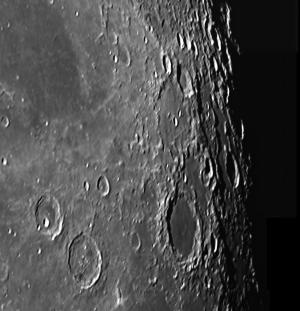
|
On the night of 31 August I imaged the terminator details again, this time when the moon was almost 17 days old. Click the image to see my results in the Endymion area. |
Messala area

|
Click this image to see my results in the Messala area. |
Cleomedes
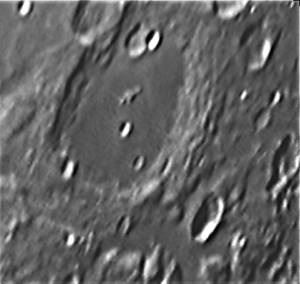
|
Click the picture for a closer view of Cleomedes |
| to top | home |
02 August 2004: 16 day moon details
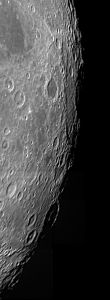
|
The moon was 16 days and 5 hours old, or two days after full, when I took a series of pictures. This link shows the resulting mosaic and many details of the NE moon area. For comparison also see the Hercules and Atlas picture below. |
| to top | home |
27 June 2004: Sinus Iridum - the Bay of Rainbows
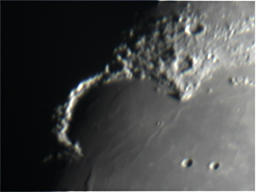
|
The Bay of Rainbows, or Sinus Iridum shown here projecting out dramatically into the night. This is a very large crater, overlapping the Mare Imbrium, which covered part of the SE wall of the crater. The northern walls form the Montes Jura mountains and include the crater Bianchini. The picture also shows the pair of craters Helicon and Le Verrier to the south east of the bay. This picture was taken with the TouCam Pro through a 2x Barlow with my 8 inch f/5 Newtonian. |
| to top | home |
22 May 2004: Langrenus and Vendelinus
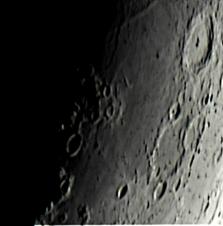
|
This picture shows the large craters Langrenus (top right) and Vendelinus (middle). Langrenus, or rather its "aged ray system" is number 85 of the Lunar 100, which puts it up in the "difficult" range. This perhaps explains why the rays cannot be seen in my photo. However, the double central mountain can be seen, as can the deformed crater walls on the south side. Vendelinus is a rather less well-defined crater to the south of Langrenus. Its walls and slopes are crushed by other craters and many small craterlets on various sides. Immediately to the north can be seen Lohse, a smaller crater with a central mountain. Opposite, on the south, is Holden, inside which can just be made out the shading of a large craterlet. |
| to top | home |
22 May 2004: Petavius
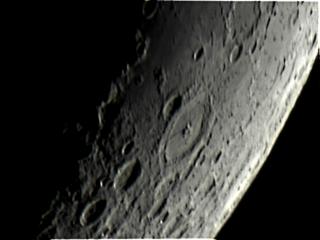
|
Petavius, number 16 in the Lunar 100, is shown here. The central mountains can be clearly seen, and some floor detail, including a deep scar stretching from the central mountain to the south westerly direction. Wrottesley, a high-walled crater with a central mountain, is located on the north-west edge of Petavius. Further to the south west can be seen the two craters Snellius and Stevinus, both heavily shadowed in this picture. |
| to top | home |
25 April 2004: Hercules and Atlas

|
Hercules (left) and Atlas (right) form an interesting pair in the North Eastern part of the moon. The crater Hercules G can be clearly seen on the floor of Hercules, and the smaller Hercules E can just be seen to the south of G on the crater wall. Atlas has a central mountain, and a rille that is not visible in this photo. |
| to top | home |
25 April 2004: Janssen and surrounding area

|
Janssen, a 196km-wide walled plain containing several craters including the large Fabricus, and a rille, rare for lunar highlands, which curves across the floor. Nearby, some 270 km to the south west of the centre of Janssen, can be seen the craters Pitiscus (containing small Pitiscus A), Vlaco (to the south east of Pitiscus) with its central mountain, and to the south of Vlaco, Rosenberger with its many craterlets. |
| to top | home |
25 April 2004: Mare Nectaris region
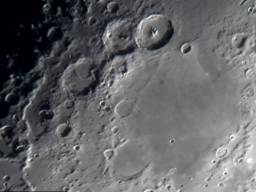
|
The Mare Nectaris ("Sea of Nectar") is very flat circular formation. Here I have captured it 5 days and 17 hours after new moon. To the West (top centre of the picture) is the centrally-peaked crater Theophilus, part of the interesting group of three with Cyrillus (to the south) and Catherina (south of Cyrillus). Cyrillus also has central mountains, and is damaged by the partially-intersecting walls of Theophilus. Catherina is separate from the other two of the group but is itself crushed by the "ghost crater" Catherina P to the north. Intersecting Mare Nectaris to the south is the 128km wide walled plain Fracastorius, whose remaining walls and slopes (lost to Mare Nectaris in the north) are dotted with craters and small craterlets. On the left-hand side of this picture can be seen the ridge and cliffs of Rupes Altai, an arc apparently concentric with Mare Nectaris, which seems to form part of the rim of the impact basin. |
| to top | home |
23 April 2004: Mare Crisium
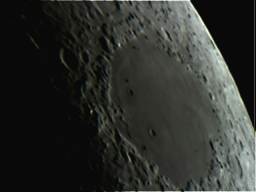
|
The Mare Crisium ("Sea of Crises") is a lava-filled basin on the eastern edge of the moon, imaged here when the moon's age was 3 days and 21 hours after new. This picture shows several of the craterlets within it, particularly the largest "Peirce" and "Picard", and immediately above Peirce, "Swift". |
| to top | home |
2 April 2004: Crater Tycho and Mare Nubium
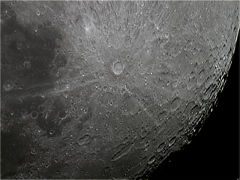
|
This is Tycho, one of the craters on the moon that displays a ray structure around it. A pair of rays goes off to the left of the picture into the dark area which is the Mare Nubium (Sea of Clouds). The black crater above the pair of rays, almost part of the Mare Nubium is Pitatus. To the right of Tycho in the picture is Clavius, with it's distinctive chain of five progressively smaller craters inside the large one. See picture from 30 March 2004 for detail of Clavius. |
| to top | home |
30 March 2004: Crater Plato and the Lunar Alps<
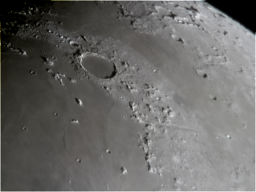
|
Here can be seen the Montes Alpes (Lunar Alps) including the Alpine Valley, and the crater Plato. Although the Alpine valley can be seen clearly, the rille running down the middle of it is beyond the capabilities of the small telescope used (114mm/f8 reflector with 2x Barlow). Beyond the Alps, in the top-right of the picture, the large W. Bond crater can be seen. This image was created from around 300 frames stacked in Registax 2, then wavelet enhancement applied. |
| to top | home |
30 March 2004: Clavius
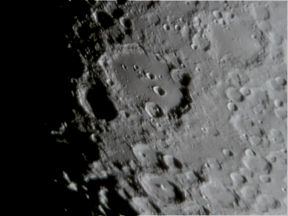
|
Clavius is an interesting crater containing a chain of at least 5 progressively smaller craters, the largest of which is Rutherfurd. On the north-east wall of the crater is Porter, a somewhat smaller crater with a central mountain. Clavius is located to the far south of the moon. This version was created from around 300 frames stacked in Registax 2. |
| to top | home |
29 March 2004: A triplet of craters
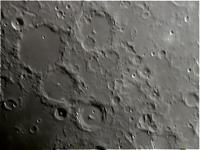
|
Another image using the 2x Barlow lens, this one shows the three craters (from top to bottom, or N to S) Ptolemaeus, Alphonsus, and Arzachel. This was not a mosaic but consists of about 300 frames aligned and stacked in Registax. |
| to top | home |
29 March 2004: Mountains around Mare Imbrium

|
An interesting mosaic, showing the mountains around the north and eastern edge of the Mare Imbrium (Montes Caucasus, Montes Caucasus, Montes Apenninus) and the crater Archimedes (including Montes Archimedes). This image is a mosaic of 6 separate images, each of which is formed from around 300 frames stacked and aligned in Registax 2 then merged with iMerge. |
| to top | home |
| 6 Sep 2003: My first Astronomy Picture: The Moon! 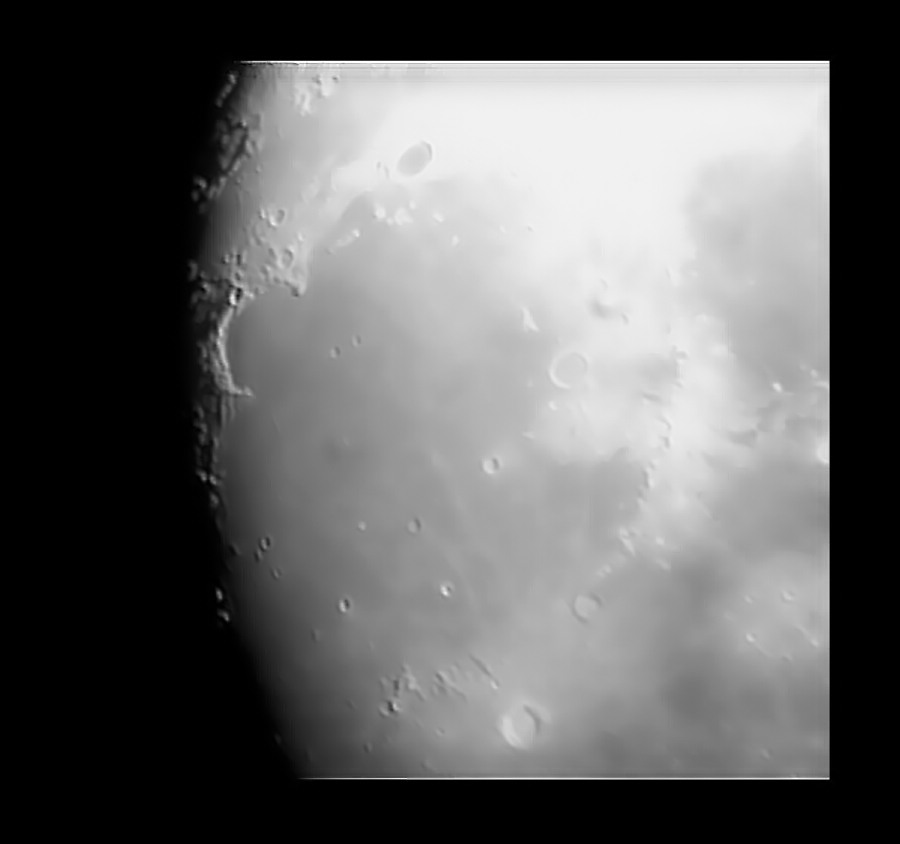
|
It shows Mare Imbrium and Sinus Iridum with craters Plato and Archimedes. Taken with an Aiptek Pencam VGA at prime focus on my Meade EQ1-B 114mm reflector, Processed with with Registax 2 and NeatImage. |
| to top | home |
 |
|
| All text and images copyright and may not be used without permission |
|